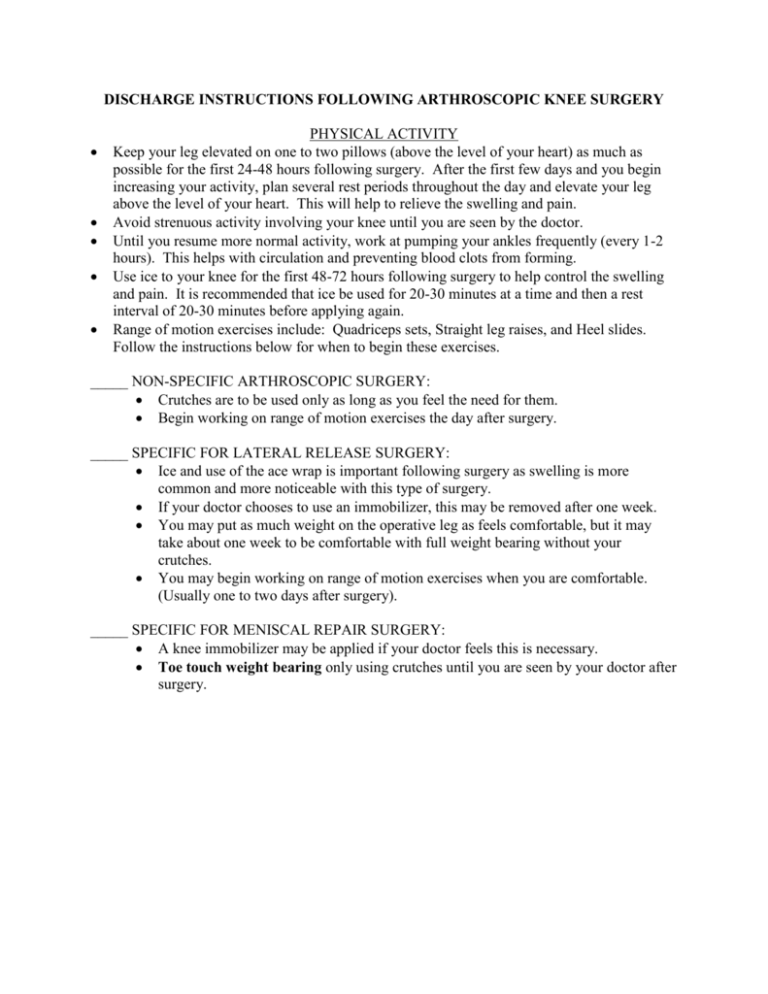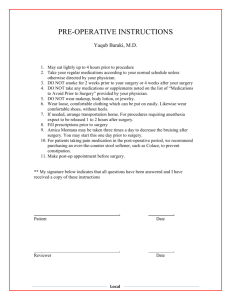discharge instructions following arthroscopic knee surgery
advertisement

DISCHARGE INSTRUCTIONS FOLLOWING ARTHROSCOPIC KNEE SURGERY PHYSICAL ACTIVITY Keep your leg elevated on one to two pillows (above the level of your heart) as much as possible for the first 24-48 hours following surgery. After the first few days and you begin increasing your activity, plan several rest periods throughout the day and elevate your leg above the level of your heart. This will help to relieve the swelling and pain. Avoid strenuous activity involving your knee until you are seen by the doctor. Until you resume more normal activity, work at pumping your ankles frequently (every 1-2 hours). This helps with circulation and preventing blood clots from forming. Use ice to your knee for the first 48-72 hours following surgery to help control the swelling and pain. It is recommended that ice be used for 20-30 minutes at a time and then a rest interval of 20-30 minutes before applying again. Range of motion exercises include: Quadriceps sets, Straight leg raises, and Heel slides. Follow the instructions below for when to begin these exercises. _____ NON-SPECIFIC ARTHROSCOPIC SURGERY: Crutches are to be used only as long as you feel the need for them. Begin working on range of motion exercises the day after surgery. _____ SPECIFIC FOR LATERAL RELEASE SURGERY: Ice and use of the ace wrap is important following surgery as swelling is more common and more noticeable with this type of surgery. If your doctor chooses to use an immobilizer, this may be removed after one week. You may put as much weight on the operative leg as feels comfortable, but it may take about one week to be comfortable with full weight bearing without your crutches. You may begin working on range of motion exercises when you are comfortable. (Usually one to two days after surgery). _____ SPECIFIC FOR MENISCAL REPAIR SURGERY: A knee immobilizer may be applied if your doctor feels this is necessary. Toe touch weight bearing only using crutches until you are seen by your doctor after surgery. 2 No squatting or kneeling. Do not bend your knee greater than 90 degrees. You may begin range of motion exercises when you are comfortable. (Usually one to two days after surgery). _____ SPECIFIC FOR PATELLAR REALIGNMENT SURGERY: The knee immobilizer needs to be worn for four weeks. You may remove your immobilizer for range of motion exercises, when lying around, and at night. However, you may be more comfortable wearing the immobilizer for the first week following surgery. You must wear the immobilizer when walking. You may work on range of motion exercises when you are comfortable. (Usually two to three days after surgery). A cool therapy device may be ordered in place of ice packs. _____ SPECIFIC FOR (AMZ) ANTERIORMEDIALIZATION SURGERY: The knee immobilizer needs to be worn for four to six weeks following surgery. You must wear your immobilizer when walking. No weight bearing to your leg. You must use your crutches. You may work on range of motion exercises when you are comfortable. (Usually one to two days after surgery). A cool therapy device may be ordered in place of ice packs. WOUND CARE Bleeding during the first 24 hours following surgery is normal. If bloody drainage is noted through the ace wrap, do not remove the existing dressing, but apply a fresh layer of dressing and a new ace wrap (elastic bandage) over top. Apply direct pressure over the area where the drainage is noted. Lie down, elevate your leg, and apply ice. If the drainage continues throughout the night, call the office for further instructions. You may remove your dressing after two to three days (unless your physician instructs you otherwise) and cover your incision sites with bandaids if necessary. Change these daily and as needed until the incision sites are completely scabbed. You may shower after the dressings are removed. Cover your incision sites prior to showering if they are draining. No tub baths, hot tubs, or swimming in a pool or lake until your incision sites are completely healed (at least two weeks). Do not submerge or soak your knee under water. You may use an ace wrap on your leg. This aids in circulation and to keep swelling down. Apply it with your leg elevated on the bed or couch. Begin at your ankle and wrap past your knee. Apply it snugly, but not too tight. If your ace wrap is too tight, your toes will swell and become discolored. If this happens, loosen the ace wrap. Swelling and discoloration/bruising of the knee is expected. This will gradually resolve. PRECAUTIONS Notify the office if you: Develop a temperature greater than 100.5 that is not associated with any other illness. It is not necessary to take your temperature every day. If you feel warm, take your temperature. Develop new or more severe pain that cannot be controlled by the pain medication. Develop redness, swelling, drainage, or foul odor from your incision sites. 3 Have persistent numbness or tingling of the foot. Develop calf pain, chest pain, or shortness of breath. Have any questions or problems. MEDICATIONS A prescription for pain medication may be given to you by your doctor prior to your discharge from the surgery center. These medications are used to reduce your pain and must not be taken any more often than prescribed. In an effort to keep your pain under good control, you should take the pain medication routinely as prescribed during the first 24-48 hours following surgery. Then, as the pain lessens, begin taking it as needed (within the prescribed guidelines). As you become more comfortable, you may substitute over-thecounter medications such as Tylenol or Ibuprofen for pain control. These medications should be used only as directed. Pain medication should be taken with food as this will help to prevent any stomach upset. Requests for pain medication should be made during normal office hours. Please Note: Pain medication will only be ordered during regular office hours. Do not drive while taking pain medications. Do not drink alcoholic beverages while taking pain medications. Ice may be used to the knee to help with swelling and pain relief. Take one full-strength aspirin once a day or one baby aspirin twice a day for two weeks following your surgery. This thins your blood and helps to prevent blood clots from forming. DO NOT TAKE ASPIRIN if you have an allergy to aspirin, have a history of ulcer disease, or if another blood thinning medication was ordered for you when you were discharged from the hospital. You may resume your routine medications unless otherwise instructed. Often pain medication and inactivity cause constipation. Eat high fiber foods (fresh fruits, vegetables, bran) and increase your fluid intake if possible. Also, you may purchase Pericolace, a stool softener, at any pharmacy to aid in alleviating your constipation. Take this two times per day. DIET After having General Anesthesia, start by taking liquids such as water or carbonated soft drinks. If this does not upset your stomach, try soup and crackers. After this, you may resume your normal diet as tolerated. FOLLOW UP You should be seen in the office for follow up 7-14 days following your surgery. Call the office when you are discharged from the surgery center to schedule this appointment. 1/2009







